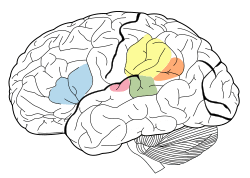Language center
The term language center or language centre (or more accurately centers, e.g. Broca's area and Wernicke's area) refers to the areas of the brain which serve a particular function for speech processing and production.[1]
Current scientific consensus
New medical imaging techniques such as PET and fMRI have allowed researchers to generate pictures showing which areas of a living brain are active at a given time. In the past, research was primarily based on observations of loss of ability resulting from damage to the cerebral cortex. Indeed, medical imaging has represented a radical step forward for research on speech processing. Since then, a whole series of relatively large areas of the brain have been found to be involved in speech processing. In more recent research, subcortical regions (those lying below the cerebral cortex such as the putamen and the caudate nucleus) as well as the pre-motor areas (BA 6) have received increased attention. It is now generally assumed that the following structures of the cerebral cortex near the primary and secondary auditory cortices play a fundamental role in speech processing:
- Superior temporal gyrus (STG): morphosyntactic processing (anterior section), integration of syntactic and semantic information (posterior section)
- Inferior frontal gyrus (IFG, Brodmann area (BA) 45/47): syntactic processing, working memory
- Inferior frontal gyrus (IFG, BA 44): syntactic processing, working memory
- Middle temporal gyrus (MTG): lexical semantic processing
The left hemisphere is usually dominant in right-handed people, although bilateral activations are not uncommon in the area of syntactic processing. It is now accepted that the right hemisphere plays an important role in the processing of suprasegmental acoustic features like prosody.
Most areas of speech processing develop in the second year of life in the dominant half (hemisphere) of the brain, which often (though not necessarily) corresponds to the opposite of the dominant hand. 98% of right-handed people are left-hemisphere dominant, and the majority of left-handed people as well.
Older models

The differentiation of speech production into only two large sections of the brain (i.e. Broca's and Wernicke's areas), accepted long before the advent of medical imaging techniques, is now considered outdated. Broca's Area was first suggested to play a role in speech function by the French neurologist and anthropologist Paul Broca in 1861. The basis for this discovery was analysis of speech problems resulting from injuries to this region of the brain, located in the inferior frontal gyrus. Lesions to Broca's Area resulted primarily in disruptions to speech production. Damage to Wernicke's Area, which is located in the lower part of the temporal lobe, lead mainly to disruptions in speech reception. This area was named for German doctor Carl Wernicke, who discovered it in 1874 in the course of his research into aphasias (loss of ability to speak).
Broca's Area is today still considered an important language center, playing a central role in processing syntax, grammar, and sentence structure.
In summary, these early research efforts demonstrated that semantic and structural speech production takes place in different areas of the brain.
See also
References
- ↑ "BROCA'S AREA , WERNICKE'S AREA, AND OTHER LANGUAGE-PROCESSING AREAS IN THE BRAIN". The Brain From Top to Bottom. Retrieved 6 November 2014.
Further reading
- Donald Loritz: How the Brain evolved Language, Oxford University Press 1999, ISBN 0-19-511874-X (hardcover), ISBN 0-19-515124-0 (paperback)
- Friederici, A.D.: Towards a neural basis of auditory sentence processing. Trends in Cognitive Sciences, 6:78, 2002.
- Kaan, E. and Swaab, T.Y.: The brain circuitry of syntactic comprehension. Trends in Cognitive Sciences, 6:350, 2002.
- Dronkers, N.F., Pinker, S. & Damasio, A.: Language and the Aphasias. In: Kandel, E.R., Schwartz, J.H. & Jessel, T.M. (eds.) Principles of Neuroscience, Fourth Edition, New York: McGraw-Hill, 2000, 1169–1187
- Ardila, A., Bernal, B. and Rosselli, M. " How localized are language brain areas? A review of Brodmann areas involvement in oral language." Archives of Clinical Neuropsychology, 31(1), 112-122, 2016.